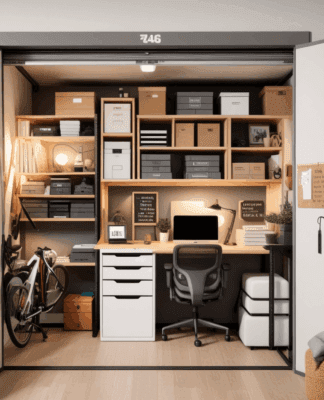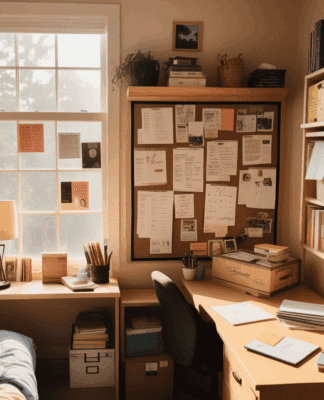 Whether you’re decluttering your home, transitioning between seasons, or preserving a prized collection, proper storage is critical. The difference between a cherished item that lasts for generations and one that ends up ruined in a damp box often comes down to a few avoidable mistakes.
Whether you’re decluttering your home, transitioning between seasons, or preserving a prized collection, proper storage is critical. The difference between a cherished item that lasts for generations and one that ends up ruined in a damp box often comes down to a few avoidable mistakes.
Let’s dive deep into the top 12 most common storage mistakes and how to avoid them with expert-backed, practical solutions.
1. Using Cardboard Boxes for Long-Term Storage
 Cardboard boxes might be the go-to option because they’re affordable and easy to find, but they aren’t ideal for long-term storage. Cardboard is vulnerable to moisture, which leads to mold, mildew, and eventual disintegration. It also invites pests like silverfish, roaches, and rodents that can chew through and damage your stored items.
Cardboard boxes might be the go-to option because they’re affordable and easy to find, but they aren’t ideal for long-term storage. Cardboard is vulnerable to moisture, which leads to mold, mildew, and eventual disintegration. It also invites pests like silverfish, roaches, and rodents that can chew through and damage your stored items.
What to do instead: Opt for clear, heavy-duty plastic bins with tight-fitting lids. These offer superior protection against moisture and pests while making it easier to see what’s inside. For collectibles, ensure the plastic is acid-free and archival-safe. Stackable bins can also help maximize vertical storage space without compromising stability.
Pro tip: Choose bins with gasket seals for added moisture protection, especially in garages or basements.
2. Skipping Climate Control for Sensitive Items
Temperature fluctuations and humidity are enemies of many materials, including paper, vinyl, fabric, electronics, and wood. Storing valuables in uncontrolled environments can lead to warping, cracking, fading, and even mold growth.
Why it matters: High humidity can cause mildew and paper degradation, while dry heat can make wood brittle or cause adhesives to fail. Items like vinyl records and vintage toys can warp or melt if left in hot storage areas like attics.
What to do instead: Use climate-controlled storage units for sensitive belongings. These spaces maintain stable temperature and humidity levels year-round, helping preserve your items in optimal condition. If you’re storing at home, consider interior closets or using a dehumidifier.
Bonus tip: Keep a hygrometer in your storage space to monitor humidity levels.
4. Ignoring Humidity and Moisture Risks
Humidity is a silent but destructive force. It causes mold, warping, rust, and even structural damage to furniture and electronics.
The problem: Even slightly damp air can seep into containers and cause irreversible harm over time. Items stored in basements, garages, or non-insulated sheds are especially at risk.
How to fix it:
- Use silica gel packs, charcoal dehumidifiers, or moisture absorbers in every container or enclosed space.
- Elevate boxes off the floor using pallets.
- Choose breathable containers for fabrics or paper items, but only in climate-controlled spaces.
Pro move: Install a portable dehumidifier in any frequently used storage room.
5. Storing Items in the Garage or Attic
It’s convenient, but garages and attics are some of the worst environments for long-term storage.
Why? They’re subject to extreme temperatures, humidity, and pests. Attics can reach oven-like temperatures in the summer, while garages may flood or allow rodents and insects easy access.
What to do instead: Store valuable or temperature-sensitive items inside your home or in a climate-controlled storage unit. If you must use the garage or attic, limit it to items that are not sensitive to heat or moisture, like plastic lawn tools or camping gear.
Bonus: Add insulation or weather stripping to improve garage or attic conditions slightly, but avoid storing irreplaceable collectibles in these areas.
6. Neglecting Labels and Inventory Lists
We’ve all been there—digging through ten boxes to find your winter coat or holiday decorations. A lack of labeling wastes time and increases the chances of mishandling or damaging items.
Why it matters: Poor labeling also makes it harder to identify fragile items, which increases the risk of dropping or stacking them incorrectly.
What to do instead:
-
Use waterproof labels on every bin or box.
-
Include contents, destination room, and handling instructions.
-
Create a master inventory list in a spreadsheet or app for quick reference.
Extra credit: Include photos of valuable items in your digital inventory for insurance documentation.
7. Wrapping Items in Newspaper or Improper Materials
It’s tempting to reach for old newspapers when wrapping up dishes or keepsakes, but ink can bleed and damage surfaces over time.
Why it’s a mistake: The ink on newspaper can transfer onto ceramics, fabrics, or photographs, especially in humid conditions. Non-archival wrapping also accelerates aging in paper and textiles.
Use this instead:
-
Acid-free tissue paper
-
Bubble wrap
-
Clean cotton sheets or towels
-
Packing paper specifically made for moving/storage
Best practice: For especially valuable or antique items, consider archival wrapping and storage boxes to prevent chemical breakdown.
8. Overpacking Bins and Boxes Without Cushioning
 Overstuffing bins to save space can cause pressure damage, especially for delicate or oddly shaped items.
Overstuffing bins to save space can cause pressure damage, especially for delicate or oddly shaped items.
What can go wrong: Items can crack, bend, or scratch each other if there’s no padding. Boxes may also split at the seams from too much weight.
How to pack properly:
-
Leave about 10-15% empty space at the top.
-
Use foam sheets, bubble wrap, or even towels to cushion fragile items.
-
Avoid stacking multiple heavy items in one box.
Packing tip: When in doubt, pack light. Multiple smaller boxes are better than one overstuffed one.
9. Failing to Use Archival-Quality Materials for Collectibles
Collectibles require extra care. Standard plastic sleeves, cardboard boxes, or binders might look fine but can cause long-term harm due to acidity and chemical off-gassing.
Why it matters: Paper-based items like trading cards, comics, and photographs are especially vulnerable. Non-archival materials can cause yellowing, brittleness, or sticking over time.
What to use:
-
Mylar or polypropylene sleeves
-
Acid-free storage boxes
-
Archival binders and pages
-
Buffered tissue for textiles and documents
Protect your investment: If you’re storing valuable items, it’s worth spending a little extra on proper materials.
10. Improper Storage of Vinyl Records and Media
Vinyl records are having a resurgence, but improper storage can cause warping, scratches, or sleeve damage.
The wrong way: Stacking records horizontally or storing them in hot, humid spaces can destroy your collection over time.
The right way:
- Store records vertically like books, with minimal lean.
- Use inner sleeves made of polyethylene or paper with poly lining.
- Keep them in a cool, dark, dry place.
- Don’t overcrowd your shelves—records need a little breathing room.
Other media tip: Apply similar principles to cassette tapes, CDs, DVDs, and vintage video games.
11. Leaving Items Directly on Concrete Floors
 Concrete might seem solid and dry, but it actually draws moisture from the ground.
Concrete might seem solid and dry, but it actually draws moisture from the ground.
Why it’s risky: Moisture wicks upward into cardboard boxes or wooden furniture, leading to mold, rust, or warping.
Simple solution: Elevate boxes using wooden pallets, plastic shelving units, or furniture risers. Add a waterproof mat underneath if the area is prone to flooding.
Pro tip: Consider sealing concrete floors in basements or garages to reduce moisture transfer.
12. Not Inspecting Storage Areas Regularly
Out of sight, out of mind? That approach can lead to costly damage.
The danger: Leaks, pests, and temperature shifts can go unnoticed for months. By the time you open the box, it might be too late.
What to do instead:
Check your stored items at least every 3-6 months. Look for moisture, mold, pest activity, or physical damage. Adjust packing or environment conditions as needed.
Bonus: Take this opportunity to update your inventory and reorganize.
Final Thoughts
Whether you’re a collector of vintage treasures or simply trying to protect seasonal items, proper storage practices can make a world of difference. Avoiding these 12 mistakes means your belongings will last longer, look better, and retain more value.
If you’re looking for a secure, climate-controlled place to store your items, consider partnering with a trusted storage provider like The Lock Up Self Storage. Your collections deserve nothing less.
Need more storage tips or preservation ideas? Stay tuned to our blog or reach out to a storage expert today.



















